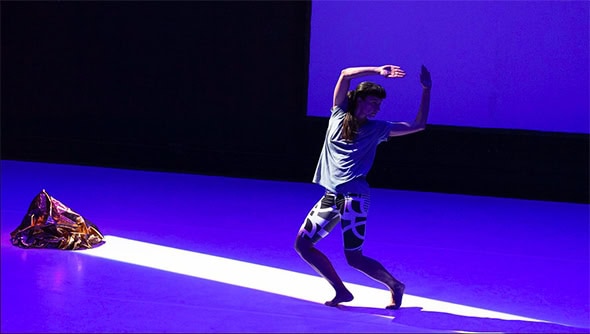Dance Umbrella 2019: Georgia Vardarou at Lilian Baylis Studio
Posted: November 1st, 2019 | Author: Nicholas Minns | Filed under: Festival, Performance | Tags: 4x4 Commission, Anne Teresa De Keersmaeker, Carl Jung, Dance Umbrella 2019, David Bergé, Georgia Vardarou, Laurel Halo | Comments Off on Dance Umbrella 2019: Georgia Vardarou at Lilian Baylis StudioDance Umbrella 2019: Georgia Vardarou, Why should it be more desirable for green fire balls to exist than not?, Lilian Baylis Studio, October 23

To celebrate the 40th anniversary of Dance Umbrella last year, the three successive artistic directors each invited an established artist from their respective era to nominate a ‘choreographer of the future’ as part of a new commissioning project, Four by Four. One of those established artists, Anne Teresa De Keersmaeker, chose Georgia Vardarou, which is how her new work, Why should it be more desirable for green fire balls to exist than not?, has received its world première at Lilian Baylis Studio as part of this year’s festival. Anyone who has seen De Keersmaeker’s work knows her as a choreographer who has released the spatial language of movement from its reliance on narrative, writing dance rather than using dance to write. Vardarou, who trained at P.A.R.T.S. in Brussels and was a member of De Keersmaeker’s company, is clearly a kindred spirit. The title of her work derives from an observation by Carl Jung in his study of the phenomenon of UFOs that it is more desirable for something to exist than to not exist. In her programme note Vardarou extends this idea: ‘If we assume that this kind of desire is part of the mechanism of watching dance then we could also assume that while watching dance we are constantly searching for something, consciously or unconsciously.’ It is this kind of philosophical questioning of dance language, with its potential for unearthing new pathways for seeing and feeling dance, that is so refreshing — and uniquely European. Vardarou’s collaborator on this project, photographer David Bergé, is similarly engaged in questioning his medium. As curator Laura Herman has noted, Bergé is ‘not especially interested in questions of representation — in solidifying time into images — but rather in understanding how the act of looking, traversing, framing, composing, or pointing to is deeply entrenched in dynamics of appropriation and articulation.’ If Bergé questions what happens between photographer and viewer, Vardarou questions where the dance is happening between performer and audience.
Vardarou enters a stage that already suggests a cognitive framework; one of Bergé’s close-up photographs of a rock surface is projected over a large black frame on the back wall so that part of the image is inside the frame while the rest bleeds beyond it. The same image is simultaneously projected at an angle on one of the side walls, distorting its optical frame. On opposite sides of the stage there are two delicate piles of space-foil material, one coloured gold, the other copper. At first Vardarou stands quite still in the corner, as if deciding how to negotiate these elements, until she begins a silent movement dialogue between herself and the audience with the confidence of one whose mind is clear; hers is a lucid form of thinking-as-movement.
The focus of Bergé’s successive photographs begins in close-up to the point of abstract patterns, but gradually draws back to reveal their architectural context; the detailed rock pattern becomes the outlines of a wall that develop into a whitewashed building that only in the final moments — after Vardarou has left the stage — reveals its location high on a cliff overlooking a sheltered beach and the open sea. Similarly, Vardarou’s initial focus is on herself, the thinking subject, but over the course of the work she uses her consummate body syntax to pull out the focus gradually to include all the stage elements as she strategises how and when to resolve them. Using the stimuli of Bergé’s set and Ana Rovira’s lighting to underpin her choreographic pathway, we follow her decisions and her indecisions until she finally achieves her goal.
Philosopher Brian Massumi has argued that ‘art is not illustrating a concept but enacting it’. The title of Vardarou’s work asks the kind of ontological question of dance to which her choreographic enactment is her response. Moreover, by separating her dance syntax from a comprehensive musical structure — although at one point she dances a delightful rhythmic path through a jazz track chosen by Laurel Halo — she urges us to ‘listen’ to her movement as a medium in its own right that can speak eloquently of phenomena, as did Jung, that resist precise logical definition. In Why should it be more desirable…? Vardarou restores the primacy of dance by inserting into the space between performer and audience — where the dance happens — an ambiguous dimension in which we can search, consciously or unconsciously, for what we desire.